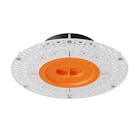Date Announced: 10 Jan 2011 -- New lighting efficiency rules take effect nationwide January 1, 2012Silver Spring, MD – Prepare to say goodbye to the venerable 100-watt “general-service” incandescent bulb. In less than one year – as of January 1, 2012 – it will be a violation of the Energy Independence and Security Act (EISA) of 2007 (Public Law 110-140) to import the bulbs to the United States or to manufacture them there. In California, state law banned the bulb as of January 1, 2011.According to the National Lighting Bureau, the nationwide ban is the first of several designed to reduce energy waste. Mary Beth Gotti, a member of the NLB’s board of directors and manager of GE Lighting’s GE Lighting Institute, said that “light bulbs are now subject to the same kind of standard used to measure automobile efficiency; output per unit of input. For automobiles, it’s measured as MPG; miles travelled per gallon of gasoline required to operate the vehicle. For light bulbs, it’s measured as LPW; that’s lumens – a measure of the amount of light produced – per watt of electric power required to operate the bulb. Conventional 100-watt incandescent light bulbs produce about 17 lumens per watt, a rating that’s too low to meet the new standards.“While the phase-out will help the nation significantly reduce electrical consumption and the greenhouse-gas emissions associated with the production of some electricity, the impact on consumers is not nearly as big a deal as some people are making it out to be,” Ms. Gotti said. “Standard-compliant halogen bulbs are readily available for those who want to keep using incandescent technology.” Ms. Gotti explained that halogen bulbs use the same incandescent principles Edison patented some 135 years ago, but they are filled with halogen, a gas that permits the lamps to burn hotter and therefore emit more lumens per watt. A 72-watt halogen lamp that looks more or less identical to a conventional 100-watt incandescent bulb is about one-third more efficient, achieving more than 20 lumens per watt. While the higher efficiency results in lower operating costs, the halogen replacement generally costs two to three times as much as a 100-watt incandescent, a cost difference that in many cases can be more than offset by the value of the energy saved over the halogen bulb’s 1,000-hour life. Compact fluorescent bulbs – properly referred to as compact fluorescent lamps or CFLs – produce about 62.5 lumens per watt, about four times the amount of light that incandescent lamps produce on a watt-for-watt basis, and they last ten times as long. The 26-watt CFL that is used to replace a 100-watt incandescent bulb costs about the same as a 72-watt halogen bulb. Although the typical CFL is a coiled device, CFLs are available in many sizes and shapes. Some are manufactured with outer bulbs that make them look just like conventional 100-watt incandescent bulbs. Dimmable CFLs also are available; only those CFLs designated as dimmable will function properly when used with a dimmer.Solid-state lighting, incorporating light-emitting diode (LED) technology, can also be used to replace incandescents. At 75 lumens per watt, the 10-watt LEDs used to replace 100-watt incandescent bulbs are about 20% more efficient than CFLs, but they can last six or more times as long; that’s about 65 to 70 times as long as conventional 100-watt incandescent bulbs. The impediment to widespread LED use is a comparatively high cost (about $30 or so for some 10-watt LEDs), but prices are rapidly declining. “The energy consumed and green-house gases associated with 100-watt incandescent bulbs are not the only concerns,” said Bureau Chair Howard P. Lewis (Lighting Alternatives, Inc.), the Illuminating Engineering Society of North America’s representative on the Bureau’s board of directors. “The bulbs’ relatively brief life span means more energy and raw materials are used for manufacture, packaging, and transportation. The lamps also produce a great deal of heat, increasing the amount of energy used for summer air-conditioning in many parts of the nation and, in some, year-round.”Despite the drawbacks they share with 100-watt general-service incandescent bulbs, most 100-watt specialty incandescent bulbs are not affected by the ban. The specialty bulbs include, among others: 3-way bulbs; appliance lights; “bug lights”; infrared and colored bulbs; shatter-resistant, vibration-service, and rough-service bulbs; bulbs used in signs; and bulbs used for marine, mine, and traffic applications. Come January 1, 2013, 75-watt general-service incandescent bulbs will begin disappearing from retailers’ shelves, followed by 60-watt and 40-watt general-service incandescent bulbs starting January 1, 2014. Halogen, CFL, and LED replacements for these three lamps are already being sold.Also affected – sooner rather than later – are many of the incandescent reflector lamps now commonly used; bulbs identified with letters such as R, ER, and PAR. Their import to and manufacture in the United States will be banned starting July 14, 2012. A number of halogen-reflector lamps (e.g., PAR 20s, PAR 30s, and PAR 38s) can already meet the new standards, and newer alternatives are being introduced almost weekly. These include incandescent reflector lamps that use advanced infrared (IR) coatings to generate more lumens per watt, and optimized-reflector coatings that direct light more efficiently. Those who wish to obtain a copy of Public Law 110-140 – the Energy Independence and Security Act (EISA) of 2007 – can do so by sending their request to [email protected] in 1976, the National Lighting Bureau is an independent, IRS-recognized not-for-profit, educational foundation that has served as a trusted lighting-information source since 1976. The Bureau is supported by the generous funding of its sponsors; professional societies, trade associations, manufacturers, and agencies of the U.S.government, including, among others:• enLIGHTen America; • GE Lighting;• GonLED, LLC;• Illuminating Engineering Society of North America (IES); • Imperial Lighting Maintenance Company;• interNational Association of Lighting Management Companies (NALMCO);• Lighting Alternatives, Inc.;• Lighting Controls Association;• Lutron Electronics Company, Inc.; • Magnaray;• National Electrical Contractors Association (NECA);• National Electrical Manufacturers Association (NEMA);• OSRAM SYLVANIA; and• U.S. General Services Administration.
Contact
Tel. 301/587-9572
E-mail:[email protected]
Web Site:www.nlb.org




